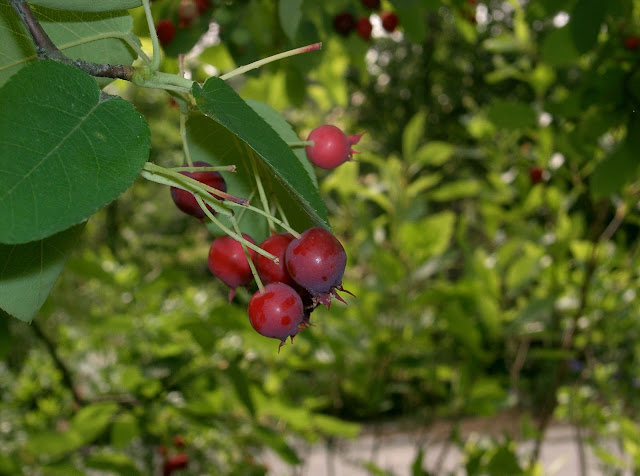Although they look a bit like blueberries, Juneberries are more closely related to the apple family. Native American communities living in Eastern North America and Canada found many uses for this showy shrub. This shrub can be found in the woods, bogs, and wetlands of Connecticut.
About Juneberry
Amelanchier Canadensis, commonly called Juneberry, is a deciduous, early-flowering, large shrub or small tree in the rose family which typically grows 15-30' tall. It is considered an understory tree that is often found growing in clumps in swamps, bogs, lowlands, and thickets. It has showy, five-petaled, slightly fragrant, white flowers that bloom in drooping clusters which appear before the leaves emerge in early spring. Finely toothed, elliptic, medium to dark green leaves (1-3" long) change to orange-red in autumn. Flowers give way to small, round, green berries which turn red and finally mature to a dark purplish-black in early summer. The fruit is apple-shaped and is usually well hidden by dark green leaves. The berries are edible and resemble blueberries in size and color when fully mature.
Culinary and Medicinal Uses
Many Native American communities found Juneberries an important and tasty source of food. Most communities ate the fruit raw or dried the fruit for future use. The Iroquois, for example, took the dried fruit on hunting expeditions. The fruit was made into a sauce or relish. Some communities combined the mashed fruit with cornbread and made small cakes. The fruit has a sweet flavor with a hint of apple.
Medicinally, one of the most common uses of this plant was to treat children with worms. The Cherokee, for example, would bathe children with worms in an infusion made from the bark of this shrub. The Chippewa made a compound decoction of the inner bark and used it as a disinfectant wash. Another popular use was gynecological. The Chippewa made a compound of the bark and gave it to women to make them strong, they also made an infusion of the root and gave it to women after they miscarried. The Iroquois made an infusion of the branches of this shrub and gave it to women after childbirth for pain and hemorrhages. Many communities made tea from the bark of the root and gave it to women to treat heavy menstrual bleeding.
The Genus name comes from a French provincial name for Amelanchier ovalis, a European plant in this genus.
Other names for this shrub include Canadian Serviceberry, Juneberry, Shadbush, chuckle berry, currant berry, thicket berry, and Junebush.
It is a host plant for the Red Spotted Purple and the Viceroy butterflies. The fruit is eaten by songbirds and large and small mammals.
_(25992630554).jpg)



No comments:
Post a Comment